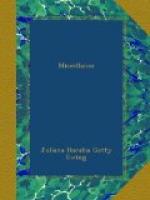Now in the New Style we keep May-day almost in Spring, and, thanks to Pope Gregory’s clever arrangement, we shall always keep it at the same season.
It is not always cold on a May-day even in the north of England. I have a vivid remembrance of at least one which was most balmy; and, when they are warm enough for out-door enjoyment, the early days of the year seem, like the early hours of the day, to have an exquisite freshness peculiarly their own. Then the month of May, as a whole, is certainly the month of flowers in the woods and fields. Autumn is the gayest season of the garden, but Spring and early Summer give us the prettiest of the wild-flowers.
“Among the changing
months May stands confest
The sweetest, and in fairest
colours drest.”
That fine weather is not quite to be relied upon for May-day, even in the Old Style, some of the old May-day customs seem to suggest. In the Isle of Man it was the custom not only to have a “Queen of May,” but also a “Queen of Winter.” The May Queen was, as elsewhere, some pretty and popular damsel, gaily dressed, and with a retinue of maids of honour. The Winter Queen was a man or boy dressed in woman’s clothes of the warmest kind—“woollen hood, fur tippet,” &c. Fiddles and flutes were played before the May Queen and her followers, whilst the Queen of Winter and her troop marched to the sound of the tongs and cleaver. The rival companies met on a common and had a mock battle, symbolizing the struggle of Winter and Summer for supremacy. If the Queen of Winter’s forces contrived to capture the Queen of May, her floral majesty had to be ransomed by payment of the expenses of the day’s festivity.
Whether the Queen of Winter conquered in bad weather, and her fairer rival when the season was warm and the flowers abundant, we are not told.
This ceremony was probably learnt from the Danes and Norwegians, who were long masters of the Isle of Man. Olaus Magnus, speaking of the May-day customs of the Goths and Southern Swedes, says, “The captain of one band hath the name and appearance of Winter, is clothed in skins of beasts, and he and his band armed with fire-forks. They fling about ashes, by way of prolonging the reign of Winter; while another band, whose captain is called Florro, represents Spring, with green boughs such as the season affords. These parties skirmish in sport, and the mimic contest concludes with a general feast.”
A few years ago in the Isle of Man the hillsides blazed with bonfires and resounded to horns on the 11th of May (May-eve, Old Style). “May flowers” were put at the doors of houses and cattle-sheds, and these were not hawthorn blossoms, but the flowers of the kingcup, or marsh marigold. Crosses made of sprays of mountain ash were worn the same night, and they, the bonfires and May flowers, were reckoned charms against “wizards, witches, enchanters, and mountain hags.”
At Helston, in Cornwall, May-day seems to have been known by the name of Furry Day. Perhaps a corruption of “Flora’s Day.” People wore hawthorn in their hats, and danced hand-in-hand through the town to the sound of a fiddle. This particular performance was known as a “faddy.”




